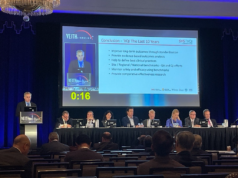
The utility of combining patient- and physician-reported scores to stratify disease severity and treatment rationale in patients with varicose veins has been highlighted in a recent study by Lowell Kabnick, Thomas Wakefield, Mikel Sadek, Jose Almeida and Glenn Jacobowitz, which sought to develop a tool for differentiating between patients with mild varices, and those with moderate to severe disease in need of intervention. Sadek (NYU Langone Health, New York, USA) presented the findings at the European Venous Forum annual meeting (EVF; 28–30 June, Athens, Greece). In discussion with the audience, concerns emerged regarding combining the two scores, as well as factors affecting insurance-covered and reimbursable treatment options for varicose veins, as Sadek argued “it is difficult to distinguish a truly symptomatic patient from one who wants treatment for cosmetic reasons”.
According to Sadek, there is a significant variation in the literature regarding management strategies and the threshold for intervention in patients with varicose veins: world-wide surveys show dramatic differences in how disease is treated in various countries. A paper from China illustrated this, showing that varicose veins—or CEAP clinical class 2 (C2) venous disease—is more aggressively treated in coastal China, with minimally invasive techniques used for less severe presentations, whereas open-surgical techniques for more severe presentations are used in Central and Western China.
This issue also extends to Europe, where the number of C2 patient treatment increases with a four-fold difference in the UK, Sweden and Finland as compared to the other European countries. Commercial and financial implications that dictate the management of varicose veins, Sadek noted, only heightens the discrepancy in treatment strategies.
“No single assessment tool provides accurate scoring for disease severity; most clearly exemplified by the variability seen in C2 patient clinical presentations,” Sadek added, which he argued has resulted in inconsistent treatment algorithms, patient care and payer reimbursement in the USA.
The purpose of Sadek and colleagues’ study was therefore to generate an algorithm that incorporates patient-reported scores using the Varicose Vein Symptom Questionnaire (VVSymQ) and physician-reported scores, using the Venous Clinical Severity Scores (VCSS), in order to improve stratification for disease severity in C2 patients.
The VVSymQ, which relies on the HASTI symptoms—heaviness, achiness, swelling, throbbing and itching—from a validated questionnaire set (developed by BTG) that came from patients directly, was initially devised from the VANISH 1 and VANISH 2 trials. Alongside this measurement, both the VCSS and the CEAP tools were used for assessment.
Consecutive patients with symptomatic varicose veins were included in this multicentre study pooled from the VANISH 1 and 2 cohorts. Patients completed a seven-day electronic daily diary (the VVSymQ) to capture the type and severity of symptoms, including reporting on the HASTI symptoms.
The relationships between the VCSS and the VVSymQ were evaluated using Pearson’s correlation. The authors also performed a frequency distribution analysis used to classify patients according to VCSS and VVSymQ.
Of the patients pooled from the VANISH 1 and 2 cohorts, 210 patients were identified with C2 disease; 73% female, with a mean age of 50 years. The scoring systems revealed the mean score for VCSS was 6.32 (range: 3–16) and 8.72 for VVSymQ (range: 1.29–22.86). This indicated a weak correlation between VCSS and VVSymQ scores (r=0.22, p=0.05), which led the authors to suggest that taking the scores independently would be an invalid assessment of disease severity.
The frequency distribution analysis indicated that 61.4% of patients had a low VVSymQ and VCSS score, indicative of mild symptomatology. Additionally, 31.3% of patients had increased VCSS (range 7–9) and VVSymQ scores (mean score 10.7), demonstrating daily symptoms of moderate severity. Furthermore, 7.3% of patients had VVSymQ and VCSS scores that were inconsistent for patients with C2 disease.
Based on these results, the authors reported that only a minority of patients fell into this category of VCSS greater than 10, meaning that these patients need to be reassessed and in fact, Sadek explained, “most of these patients did not have C2 disease on review of the source data”.
In relation to mild symptoms (VCSS scores of 6 or less), there was a good correlation with low VVSymQ scores, as most of the averages fell below 7 or less. The patients with clinically significant disease from a physician’s perspective with VCSS scores of 7–9 similarly correlated with the average VVSymQ score of 7 or greater. The cumulative average of the three was 10.7; suggesting the scoring systems correlate well together.
The authors conclude that these data highlight the utility in combining patient reported scores and physician reported scores in order to stratify for disease severity and treatment rationale in patients with varicose veins. Specifically, for patients with combined elevated VCSS and VVSymQ scores, moderate to severe disease severity is corroborated, and interventional treatment may be warranted. For patients who do not meet the combined score criterion, the disease severity is likely mild and conservative therapy such as lifestyle modification and compression treatment may be the more appropriate treatment, yet this remains a topic of debate, as highlighted in the audience discussion outlined below.
Moving forward with this algorithm and combined approach, Sadek noted that additional prospective and population-based studies are required to validate the efficacy of this approach.
During the discussion, members of the audience raised some important issues regarding the criteria for patients to be considered for treatment. Although patients enrolled in this study needed a VCSS score of 7–9 for treatment to be considered, one audience member reitrated that “in the majority of studies including patients with C2 disease, the VCSS needed for treatment is lower.” However, Sadek maintained that the higher threshold for treatment is more in line with current debate in the USA, which he says is about whether to include any C2 patients at all in reimbursement and insurance coverage. In order to be able to “lead this discussion rather than to have it lead for us and completely eliminate the treatment of C2 disease all together”, the authors opted for a more conservative higher threshold. As a result, Sadek noted only approximately one third of patients evaluated in the study were treated with interventions, and added “whether it is appropriate or not, I think that is what need ongoing validation… perhaps the threshold is too high, but it is tough to tell without more data.” On further questioning, Sadek suggested that maybe the criteria should be modified so the number of patients considered appropriate for treatment is adjusted to 50–70% of patients with varicose veins.
“It is hard to distinguish a truly symptomatic patient to one who wants treatment for cosmetic reasons”, Sadek explained, and added that “physicians must be selective” due to financial, political and “all sorts of pressures” currently pushing in the direction of no treatment. Additionally, he noted that although the authors know a certain percentage of patients will deteriorate to C3 and C4 over time, they are unsure as to whether an interventional treatment strategy will decrease this risk overall.
Audience discussion further highlighted the difficulties of correlating symptoms and signs, and whether these should remain separate in assessments. Sadek acknowledged that they in fact do not correlate, yet suggested that this was almost a justification in combining them, as it resulted in a clinically significant cohort. He recognised that this is a challenging topic—whether it is valid to combine them to begin with. He reiterated, however, that “this just happened to be one method that seemed to find a clinically significant cohort of patients, from both the patients’ and physicians’ perspective.”
Sadek concluded that the data presented are indicative of one hypothesis-generating idea, meaning additional prospective studies are undeniably needed to validate the efficacy of this approach.









